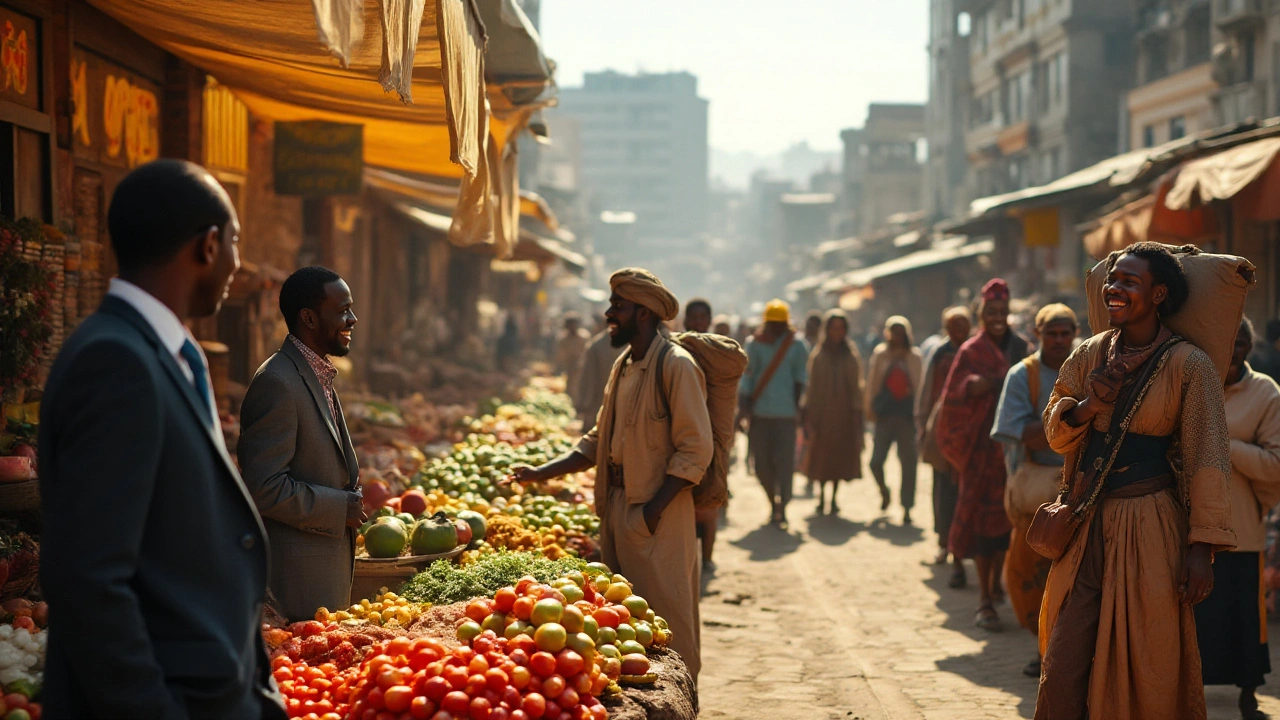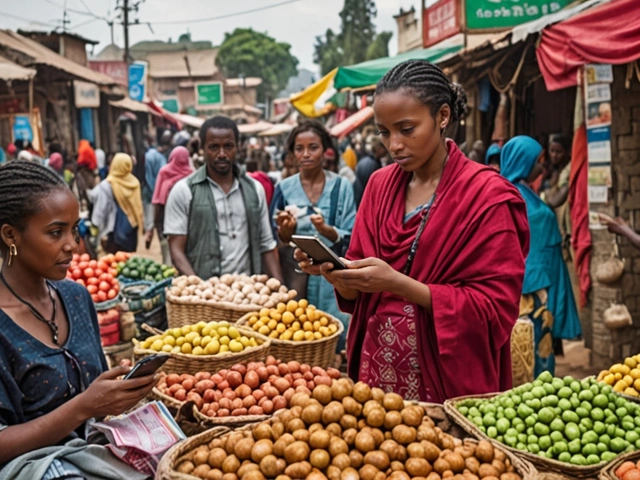In this article, we will delve into the daily earnings of the people living in Ethiopia, a country known for its rich cultural heritage and varied landscapes. This topic is important to understand the broader economic conditions and the quality of life of its residents.
We will start by taking a look at the general state of the Ethiopian economy. The economy of Ethiopia is quite diverse, ranging from modern urban industries to traditional rural agriculture. Each sector contributes differently to the overall earnings of individuals.
Next, we'll compare the income disparities between urban and rural areas. Urban residents often have better access to higher-paying jobs and infrastructure, while rural areas may rely heavily on agriculture and small-scale trade.
Moving forward, we'll discuss the factors that influence income levels in Ethiopia. These include education, employment opportunities, geographical location, and social factors. Understanding these can help explain the wide range of incomes seen across the country.
We'll then explore typical earnings across different sectors such as agriculture, industry, and services. Each sector offers different earning potentials, affecting the average income people take home each day.
We'll also cover the cost of living in Ethiopia, as it's vital to understand how daily income aligns with daily expenses. Knowing this will provide a clearer picture of the economic struggles or stability faced by the average Ethiopian.
Finally, we'll examine future economic trends. Ethiopia is a country with significant growth potential, and understanding the direction it's headed can provide insights into future income levels and economic stability.
- Introduction to Ethiopia's Economy
- Urban vs. Rural Income Disparities
- Influences on Income Levels
- Typical Earnings Across Different Sectors
- Cost of Living in Ethiopia
- Future Economic Trends
Introduction to Ethiopia's Economy
When discussing the Ethiopian economy, it’s important to recognize its unique blend of modern and traditional elements. Ethiopia, located in the Horn of Africa, has one of the fastest-growing economies in the region. This growth is driven by several factors, including agriculture, industry, and services. Agriculture remains a cornerstone of the economy, accounting for a significant portion of employment and GDP.
Historically, Ethiopia has been a largely agrarian society. Even today, agriculture is central to the livelihood of many Ethiopians, especially in rural areas. Coffee is one of the country's main exports, making Ethiopia the largest coffee producer in Africa. Other key crops include teff, maize, and wheat, which are staples in the Ethiopian diet. However, reliance on agriculture leaves the economy vulnerable to climate change and market fluctuations.
The industrial sector is evolving as well. Factories producing textiles, leather goods, and processed foods are becoming more common, particularly around the capital city, Addis Ababa. This growth in industry provides new job opportunities and supports urban income levels. Investments in infrastructure, such as the construction of the Addis Ababa-Djibouti Railway, also play a crucial role in economic development.
Services, including tourism and banking, contribute significantly to the economy. Tourism has been expanding, thanks to attractions like the ancient city of Lalibela and the Simien Mountains. Additionally, financial services are becoming more accessible, promoting entrepreneurship and small business growth. This diversification supports a more stable economic environment.
A noteworthy aspect of Ethiopia's economic growth is the investment from foreign countries. Nations like China and Turkey have invested heavily in Ethiopian infrastructure and manufacturing. These partnerships have improved roads, railways, and industrial parks, fueling economic activities and increasing the average income for urban dwellers.
Despite these advancements, the economy faces challenges. High unemployment rates, particularly among the youth, remain a significant issue. Inflation and a volatile political climate also pose risks. However, government initiatives aimed at reducing poverty and improving education and health care are steps in the right direction. A fascinating quote by the World Bank encapsulates the hurdles ahead:
"Ethiopia has made remarkable progress over recent years, but economic vulnerabilities and external pressures could threaten its future growth."
In summary, Ethiopia’s economy is a complex and evolving landscape. With its strong foundation in agriculture, burgeoning industrial sector, and growing services, the country stands at an interesting crossroads. As investments continue and challenges are addressed, the economic trajectory appears promising, offering hope for improved daily living standards for all Ethiopians.
Urban vs. Rural Income Disparities
Ethiopia is a country of contrasts, and nowhere is this more apparent than in the income disparity between urban and rural areas. Cities like Addis Ababa, the capital, offer a glimpse into modern living with bustling markets, high-rise buildings, and a plethora of job opportunities. This stands in stark contrast to rural areas, where agricultural activities dominate and access to basic services can be limited.
In urban areas, the average daily income is considerably higher than in rural settings. Professionals in cities often work in industries such as banking, IT, and hospitality, earning salaries that can sustain a relatively comfortable lifestyle. According to the Ethiopian Central Statistics Agency, the average daily wage in urban areas can range from approximately 100 to 300 Ethiopian Birr (ETB). This income allows for access to better healthcare, education, and recreational facilities.
However, in rural areas, daily earnings tell a very different story. Agriculture remains the backbone of rural life, with most families relying on subsistence farming. The income from such activities is often low and unpredictable due to factors like weather conditions and market fluctuations. Rural laborers might earn as little as 10 to 30 ETB per day, making it difficult to meet even basic needs.
The disparity is further emphasized by the accessibility to essential services. Urban residents typically have better access to schools, hospitals, and clean water. On the other hand, rural communities often struggle with inadequate transportation and infrastructure, making economic progress an uphill battle. This lack of access stifles opportunities for upward mobility and increases the income gap.
A World Bank report notes that urbanization has been one of the critical factors driving economic growth in Ethiopia. Cities are hubs of innovation and economic activity, attracting investments and providing employment opportunities. Urban dwellers also have better chances of participating in the formal economy, gaining benefits like job security and social insurance which are less common in rural areas.
The World Bank states, "Urbanization has played a significant role in Ethiopia's economic growth, yet much remains to be done to bridge the gap between urban and rural incomes."
Interestingly, the Ethiopian government has been undertaking initiatives to mitigate this divide. Programs aimed at improving rural infrastructure, enhancing agricultural productivity, and promoting rural entrepreneurship are being implemented. These efforts are crucial in creating more balanced economic opportunities across the country.
Despite these initiatives, challenges remain. Education is a significant determinant of income and remains less accessible in rural regions. Poor roads and transportation networks make it difficult for rural inhabitants to access markets to sell their products or seek employment in urban centers. Additionally, rural areas often face higher rates of poverty, limiting their ability to invest in tools and resources that could enhance their economic prospects.
Addressing these disparities will require sustained efforts and policies that focus on inclusive growth. Only by ensuring that opportunities reach the most remote corners can Ethiopia hope to create a more equitable economic landscape. Understanding the multifaceted nature of urban and rural incomes is essential for anyone interested in the economic fabric of this fascinating country.

Influences on Income Levels
The income levels in Ethiopia are influenced by a myriad of factors. Start with education. Access to quality education plays a pivotal role in determining income potential. Individuals with higher educational qualifications often find better-paying jobs, especially in urban areas. Unfortunately, many rural regions face a shortage of schools and qualified teachers, leading to a gap in educational attainment and consequently, income levels.
Geographical location is another major factor. Urban areas like Addis Ababa offer more job opportunities in industries such as technology, finance, and services. Conversely, the rural economy is mostly driven by agriculture, which is often subject to seasonal fluctuations and climate conditions. The disparity between rural and urban incomes is significant, with urban dwellers typically earning much more.
Employment opportunities are crucial. Government data indicates that sectors like education, healthcare, and professional services tend to offer more stable and higher incomes. Meanwhile, those employed in small-scale farming and informal sectors often struggle with inconsistent earnings. The nature of employment, permanent or temporary, also plays a role.
Social factors cannot be overlooked. Family background, social networks, and community ties can influence income levels. Being part of a well-connected community can open doors to better job prospects. On the other hand, individuals from marginalized communities might find it harder to break into lucrative job markets.
One interesting aspect is the level of industrialization. More industrialized regions tend to provide better-paying jobs. Ethiopia has seen a rise in industrial parks like the Hawassa Industrial Park, providing many with higher income opportunities compared to traditional farming.
Economic policies can influence incomes as well. Government initiatives aimed at boosting employment and investing in infrastructure can create more job opportunities and improve income levels. Policies favoring agricultural development or offering subsidies can stabilize rural incomes.
According to a World Bank report, the average gross national income per capita in Ethiopia is around USD 890 per year. This figure explains why many people struggle to meet daily expenses. However, efforts are being made to improve this situation through various developmental projects.
Lastly, technology is starting to play a role. With increased mobile penetration and internet access, more Ethiopians are finding innovative ways to earn money, be it through mobile banking or e-commerce platforms. These technological advancements offer new avenues for income generation.
Ethiopian Prime Minister Abiy Ahmed once said, "Our aim is to transform Ethiopia from an agrarian economy to an industrial one. This will uplift the income levels of our citizens substantially."
Typical Earnings Across Different Sectors
When looking at the daily earnings in Ethiopia, it's essential to consider the diversity across its economic sectors. The country's economy is uniquely divided into three primary sectors: agriculture, industry, and services. Each of these sectors provides differing earnings opportunities for its workforce, reflecting the economic health and developmental milestones of the nation.
Agriculture remains the backbone of Ethiopia's economy, employing nearly 70% of the population. Despite its prevalence, daily earnings in agriculture are often lower compared to industrial and service sectors. Small-scale farmers typically earn between 50 to 100 Ethiopian Birr (ETB) per day, which translates to approximately 1 to 2 US dollars. These earnings can fluctuate based on seasonal factors, crop yield, and market prices.
The industry sector has been growing steadily, thanks to government policies aimed at boosting manufacturing and infrastructural development. Workers in this sector, particularly those involved in textile and garment manufacturing, can earn between 150 to 250 ETB per day. This is higher than agricultural earnings but still modest by global standards. Skilled laborers, such as those in construction or specialized manufacturing, may earn even more, reflecting their higher training and expertise.
The services sector is the most diverse in terms of job opportunities and earnings potential. This sector includes everything from retail and hospitality to education and healthcare. Urban professionals like teachers, healthcare workers, and retail managers often earn daily incomes ranging from 200 to 500 ETB. For instance, a teacher might earn around 300 ETB daily, while healthcare professionals could see slightly higher earnings due to the specialized nature of their work.
Agriculture
Let's delve deeper into the agricultural sector. Small-scale farming is prevalent, and many farmers depend on subsistence agriculture, which means they grow food primarily to feed their families rather than for commercial purposes. This model of farming often results in lower daily earnings due to limited surplus produce to sell in markets. However, cooperative farming and government aid programs are beginning to offer more opportunities for increased revenues.
Industry
The industrial sector, while not as dominant as agriculture, shows promise with its sustained growth. Ethiopia's focus on becoming a manufacturing hub, particularly for textiles and leather goods, has provided job opportunities that offer better daily wages compared to agriculture. As Ethiopia strives to enhance its industrial capacity, wages in this sector may rise, creating a more attractive alternative for workers from rural areas.
Services
The services sector covers a broad range of jobs. In urban areas, jobs in this sector offer relatively high wages due to the demand for skilled and semi-skilled labor. For example, a waiter in a city restaurant might earn around 150 ETB per day, whereas tech employees or administrative professionals in the capital, Addis Ababa, could earn significantly more. This variety in job types and wages makes the service sector an essential component of Ethiopia's economy.
"Ethiopia's commitment to economic diversification is key to understanding income variations across different sectors," says Dr. Abebe Sileke, an economist specializing in Ethiopian economic development.
This diverse economic landscape means that daily income can vary widely depending on the sector and region. Understanding these typical earnings allows a more nuanced view of the economic realities faced by the Ethiopian populace. As the country continues to develop, these sectors could witness changes that might further influence daily earnings across the board.

Cost of Living in Ethiopia
The cost of living in Ethiopia can vary greatly depending on whether you're in a bustling urban center like Addis Ababa or a more tranquil rural village. In the capital city, expenses are predictably higher, reflecting the wider availability of goods and services, as well as higher income levels. Conversely, rural areas tend to have lower costs but also correspondingly lower incomes, creating a different economic reality for their residents.
Housing costs take up a sizable portion of the monthly budget for many Ethiopians. In urban areas, renting an apartment can range from $200 to $500 per month, depending on the neighborhood and amenities. For instance, centrally located apartments in Addis Ababa come with premium prices, while suburban areas are more affordable. Rural housing is often simpler and less expensive, but it can lack some of the conveniences found in the city.
Food expenses are another significant part of the cost of living. In urban centers, dining out or purchasing ingredients from markets can add up quickly. Bread, traditional stews like Doro Wat, and local produce are staples, but imported goods can be expensive. Rural areas might rely more on locally grown produce and livestock, which can reduce costs. However, limited variety and access to certain goods can pose challenges.
The cost of utilities is worth noting as well. Electricity, water, and gas are essential, with urban areas generally offering more reliable services. Monthly utility bills can range from $50 to $100 in cities, depending on usage and size of the living space. Rural areas might have lower bills but can face frequent outages or limited access to these utilities.
Transportation costs fluctuate based on where you live. In cities like Addis Ababa, public transportation is a viable and relatively inexpensive option, with buses and minibuses providing widespread coverage. Owning a car introduces additional expenses like fuel, maintenance, and insurance. In rural regions, transportation might be less structured, often relying on shared vehicles or walking.
Healthcare expenses are another crucial factor. Ethiopia's urban centers have better access to hospitals and clinics, with private facilities offering higher standards of care at higher costs. Rural healthcare services might be limited to smaller clinics with fewer resources. Having health insurance can mitigate some costs, but it's not universally accessible.
According to the World Bank, "The consumer price index (CPI) in Ethiopia has shown considerable fluctuations between urban and rural areas, affecting residents' purchasing power and cost of living."
Education costs also impact families, with urban centers offering a range of private schools, international schools, and universities. These institutions generally charge tuition fees, which can be substantial. Rural areas often rely on government schools, which are less expensive but might lack resources.
Entertainment and leisure activities also influence costs, with urban areas providing a variety of options such as theaters, restaurants, and sports facilities. These activities can add to the monthly budget. In rural areas, entertainment might be more community-focused and less costly, reflecting different lifestyle patterns.
Ethiopia's cost of living is intricately tied to where and how people live. Urban centers offer opportunities and amenities at a cost, while rural areas provide a simpler and often less expensive way of life. Understanding these dynamics offers a clearer picture of the economic landscape in this diverse country.
Future Economic Trends
Looking ahead, Ethiopia's economic future holds significant promise, driven by various key factors and ongoing initiatives. As one of Africa's fastest-growing economies, Ethiopia is on the brink of transformative development that may soon improve the daily earnings of its citizens. The government has been proactive in implementing policies aimed at fostering economic development and reducing poverty levels.
One significant trend is the focus on industrialization. The Ethiopian government envisions transforming the country into a manufacturing hub by establishing multiple industrial parks. These parks, such as the Hawassa Industrial Park, are designed to attract international investors and create jobs. This initiative aims to provide higher-paying employment opportunities, especially in urban areas, contributing to enhanced living standards.
The expansion of infrastructure projects is another promising aspect. The government is investing heavily in improving roads, railways, and electricity supply. The Addis Ababa-Djibouti Railway, for instance, has already begun to bolster trade efficiency. Such developments are expected to facilitate smoother business operations and attract more foreign direct investments, which could, in turn, lead to higher incomes for the local population.
A growing emphasis on the agricultural sector's modernization is noteworthy too. Agriculture remains the backbone of Ethiopia's economy, employing a large portion of the population. Through strategic investments and initiatives, like the Agricultural Growth Program, the government aims to increase productivity and income for smallholder farmers. Improving agrarian practices and integrating modern technology can substantially uplift the rural economy.
The Ethiopian service sector has also shown significant growth, with particular advancements in the information and communication technology (ICT) sector. The rise of tech hubs and increased internet penetration are helping the youth tap into global markets. This has opened doors for freelance opportunities, startups, and increased wage brackets. ICT could well become one of Ethiopia's major drivers of economic growth, providing numerous avenues for boosting daily income levels.
An emerging factor is the nation's open door policy for tourism. Ethiopia, with its rich historical sites, diverse culture, and natural beauty, is positioning itself as a top travel destination. With projects like the Beautifying Sheger initiative in Addis Ababa and other tourism development plans, the sector is expected to grow significantly. This growth can create numerous job opportunities and increase the average daily income, particularly in hospitality and related services.
The World Bank recently noted, "Ethiopia's potential for rapid economic transformation is underpinned by several structural initiatives that are set to bear fruit in the coming years."
Finally, policies aimed at enhancing education and skill development are paving the way for a more skilled workforce. The quality of education is being improved through various governmental programs, which are aligned with market needs. A better-educated populace can command higher wages, contributing positively to the average income.
To summarize, if Ethiopia continues to follow its current path of comprehensive development across various sectors, coupled with sound economic policies, the future of its economy looks promising. As these initiatives take root, we can anticipate a significant increase in the average daily income, elevating the quality of life for many Ethiopians.

 Earn Money Online by Watching Videos in Ethiopia: An Expert Guide
Earn Money Online by Watching Videos in Ethiopia: An Expert Guide
 Exploring the Effectiveness of Mobile Money in Ethiopia
Exploring the Effectiveness of Mobile Money in Ethiopia
 Understanding Harmful Traditional Practices in Ethiopia: A Career Awareness Guide
Understanding Harmful Traditional Practices in Ethiopia: A Career Awareness Guide
 Starting a Business in Ethiopia: Opportunities, Challenges, and Tips for Entrepreneurs
Starting a Business in Ethiopia: Opportunities, Challenges, and Tips for Entrepreneurs
 Most Profitable Investments in Ethiopia for 2024
Most Profitable Investments in Ethiopia for 2024
Christian Barthelt
August 16, 2024 AT 17:38Interesting overview, but it glosses over some crucial inconsistencies. For instance, the article mentions “fast‑growing economy” yet fails to reconcile that with the persistently high unemployment rates. Also, the distinction between urban and rural wages could use actual recent figures rather than vague ranges. The piece would benefit from a tighter focus on data sources and more precise language. Otherwise, I appreciate the effort to cover a broad topic in one go.
Ify Okocha
August 21, 2024 AT 10:03The analysis is a shallow veneer that pretends to be insightful while ignoring the stark reality of poverty. It cherry‑picks optimistic statistics and downplays the chronic under‑investment in rural infrastructure. By dousing the narrative in euphemisms, it masks the systemic failures that keep billions in subsistence. The author seems more interested in sounding hopeful than confronting the grim numbers. This kind of sugar‑coating does a disservice to anyone truly seeking to understand Ethiopia’s economic challenges.
William Anderson
August 26, 2024 AT 02:28Well, I suppose the article tries its best, but it reads like a half‑hearted school essay. The prose is riddled with generic buzzwords, and the “dramatic” shift from agriculture to industry feels forced. It tries to sound grandiose yet ends up sounding lazy, as if the author copied a Wikipedia snippet and called it a deep dive. A bit more rigor would spare us the pretentious fluff that currently drags the piece down.
Sherri Gassaway
August 30, 2024 AT 18:53One might wonder why the narrative flirts with optimism without confronting the philosophical weight of inequality. The dichotomy between urban allure and rural hardship is not merely economic; it mirrors a deeper existential divide. When we consider the human condition, the numbers become stories of aspirations bruised by circumstance. Thus, any analysis that sidesteps this dimension risks remaining superficial.
Milo Cado
September 4, 2024 AT 11:19Great points raised above! I’m encouraged by the sections that highlight Ethiopia’s industrial parks and the government’s push for tech hubs. Those initiatives could really level the playing field for young professionals. Let’s keep the conversation focused on constructive solutions and celebrate the strides being made, while staying realistic about the hurdles.
MONA RAMIDI
September 9, 2024 AT 03:44Honestly, this article is another bland recap that does nothing for anyone desperate for change. The “future trends” paragraph reads like a corporate brochure, ignoring the daily grind of workers who barely earn enough for food. If the author truly cared, they’d spotlight the voices of those on the ground, not just glossy statistics.
grace riehman
September 13, 2024 AT 20:09Hey folks, just wanted to add that while the data is important, we should also remember the cultural richness that shapes how people earn a living. From coffee ceremonies to local market vibes, Ethiopia’s spirit is as vital as its GDP numbers. Let’s celebrate that diversity while we discuss numbers.
Vinay Upadhyay
September 18, 2024 AT 12:34Oh, bravo for the “comprehensive” overview-if you consider missing citations a comprehensive feat. The article boasts about growth while skimping on the gritty details of why wages stay stagnant. Sarcastically, I’m sure the author thinks this will suffice for a nuanced discussion.
Eve Alice Malik
September 23, 2024 AT 04:59I'm curious how the recent telecom expansion has impacted daily earnings for freelancers. It seems like a game changer for remote work, but the article barely touches on that. Any thoughts on real‑world examples?
Debbie Billingsley
September 27, 2024 AT 21:24It is clear that any narrative undermining the Ethiopian people’s resilience is an affront to our national pride. The article must acknowledge the unwavering spirit that drives the nation forward, regardless of statistical setbacks.
Patrick Van den Berghe
October 2, 2024 AT 13:50Interesting point about telecoms but missing context on rural rollout.
Josephine Gardiner
October 7, 2024 AT 06:15The exposition presented offers a thorough examination of Ethiopia’s multifaceted economy. It judiciously delineates the variances between urban and agrarian sectors, thereby furnishing readers with a nuanced comprehension of prevailing income disparities.
Jordan Fields
October 11, 2024 AT 22:40Data matters.
Divyaa Patel
October 21, 2024 AT 07:30When we gaze upon the sprawling tapestry of Ethiopia’s economic landscape, one cannot help but feel the pulse of history throbbing beneath the surface, a rhythm that has endured through empires and revolutions alike. The ancient coffee ceremonies, for instance, are more than mere cultural rites; they are the very lifeblood of countless families whose mornings begin with the fragrant aroma of roasted beans, a modest profit that sustains generations. Yet, as urban skylines rise, the contrast becomes stark: a young engineer in Addis Ababa might command three hundred birr a day, while a farmer in a remote highland village scrapes together a mere fifteen birr, barely enough for sustenance after accounting for the price of seeds and fertilizer.
Education, that elusive ladder, ascends unevenly across the nation. In well‑funded city schools, students sit at desks equipped with digital tablets, learning to code and negotiate in the global market, whereas in many rural hamlets, chalkboards still bear the dust of hand‑written lessons, and teachers rotate seasonally, bringing only fleeting stability. This disparity in human capital inevitably translates into wage gaps that deepen with each passing year.
Geography, too, plays its cruel hand. The fertile Rift Valley yields bountiful harvests, turning farmers into modest entrepreneurs. Conversely, the arid lowlands wrestle with droughts that strip the soil of life, leaving families to barter labor for food rather than profit from it. The government’s recent irrigation projects promise relief, but the bureaucratic tide moves at a glacial pace, often hampered by funding bottlenecks and logistical snarls.
Industrial parks, such as the burgeoning Hawassa complex, inject optimism into the narrative. Here, textile workers assemble garments destined for distant wardrobes, earning wages that eclipse what their agricultural counterparts might ever see. Yet this industrial boon is not without its shadows: labor rights debates surface, calling into question whether the rapid pace of production respects the dignity of the workforce.
The service sector, especially tourism, offers sparkling glimpses of future prosperity. Visitors drawn to the rock‑hewn churches of Lalibela or the mist‑clad Simien Mountains pour money into local economies, spawning hotels, guides, and souvenir stalls. However, tourism is fickle, vulnerable to global travel trends and health crises, as the recent pandemic starkly demonstrated.
Amidst all these layers, one undeniable truth persists: the cost of living in Ethiopia, though lower than many Western nations, can be prohibitive for those earning at the bottom rung. A single cup of tea, a modest transport fare, or a basic medical consultation can swallow a day's earnings, leaving little room for savings or education.
Looking ahead, the country's ambition to transform into an industrial hub holds promise, yet it hinges upon sustained investment, transparent governance, and inclusive policies that bring the rural periphery into the fold of progress. Only then will the daily income of an Ethiopian, whether sowing seeds or stitching fabrics, reflect a shared ascent toward greater prosperity.
Larry Keaton
October 25, 2024 AT 23:55Wow, that was a heck of a deep dive! I totally get the vibe you’re throwing-Ethiopia’s got mad potential, but the grind is real for a lot of folks. Let’s keep lifting each other up and share more on‑the‑ground stories, okay? Peace.
Liliana Carranza
October 30, 2024 AT 15:21Love the energy here! If you’re feeling stuck, remember there’s always a way to turn a small win into a bigger leap. Keep pushing, and let’s celebrate every step forward together!
Jeff Byrd
November 4, 2024 AT 07:46Oh yeah, because a motivational pep‑talk solves structural poverty. Nice try, but we all know the real fixes need policy, not just good vibes.
Joel Watson
November 9, 2024 AT 00:11The treatise presented is undeniably sophisticated, yet it flirts with an air of elitism that may alienate the very audience it aims to inform. A balance between academic rigor and accessible prose would serve the discourse better.
Chirag P
November 13, 2024 AT 16:36I appreciate the thoroughness of the article, but I’d encourage a stronger emphasis on community‑driven initiatives that empower local stakeholders. Such grassroots efforts complement top‑down policies nicely.
RUBEN INGA NUÑEZ
November 13, 2024 AT 16:36Excellent breakdown! Let’s keep the discussion moving forward, highlighting both data and lived experiences so we can all gain a clearer picture of Ethiopia’s economic trajectory.